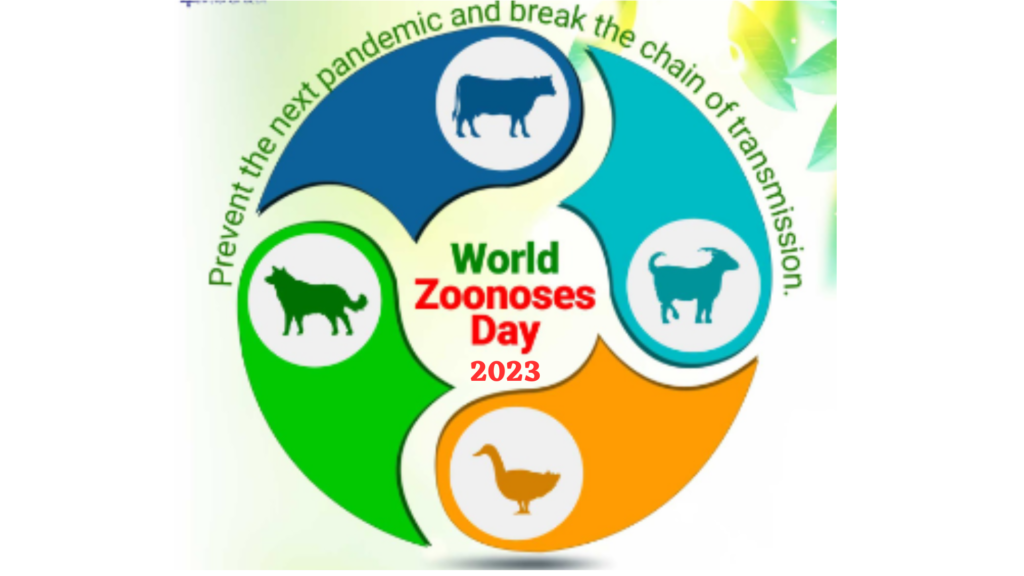World Zoonoses Day 2023


Zoonoses/ Zoonosis refers to an infectious disease that can be transmitted between species, either from animals to humans or vice versa. According to the World Health Organization, zoonotic pathogens can be bacterial, viral, parasitic, or involve unconventional agents. They can spread to humans through direct contact, contaminated food or water, or environmental factors. Zoonoses pose a significant public health concern worldwide due to our close interaction with animals in various contexts such as agriculture, companionship, and natural environments. Additionally, zoonoses can disrupt the production and trade of animal products for food and other purposes. World Zoonoses Day is observed each year to commemorate the development of the first vaccination against this group of diseases.
Theme
PREPAREDNESS FOR FUTURE EPIDEMIC/PANDEMIC LESSONS LEARNT FROM COVID-19
Date
Every year, on July 6, World Zoonoses Day is celebrated to honor the day when the first vaccination was developed to combat zoonoses.
History
On July 6, 1885, the French chemist and microbiologist Louis Pasteur successfully created the first vaccination against the rabies virus. Rabies is a zoonotic disease that can be transmitted between different species. Zoonotic diseases, whether vector-borne or food-borne, have a reputation for spreading rapidly among animals and humans.
Significance
Zoonotic diseases can spread through various means, including mosquito bites and ticks. The World Health Organization states that zoonoses account for a considerable portion of newly identified infectious diseases, including those that are already known. Some diseases, like HIV, initially originate as zoonoses but eventually, mutate into strains that affect only humans. Other zoonoses can cause recurring outbreaks, such as Ebola virus disease and salmonellosis. Additionally, certain zoonotic diseases, such as the novel coronavirus responsible for COVID-19, have the potential to trigger global pandemics. World Zoonoses Day 2023 commemorates the development of the first vaccination against these diseases and aims to raise awareness among people regarding these illnesses.
Zoonoses: Understanding the Risks and Prevention
Introduction
In our interconnected world, it’s essential to recognize the potential risks associated with diseases that can be transmitted between animals and humans. Zoonoses, a term referring to diseases that can be passed from animals to humans, have gained significant attention in recent years. This article aims to provide a comprehensive understanding of zoonoses, exploring their causes, transmission methods, prevention strategies, and the importance of public awareness.
What Are Zoonoses?
Zoonoses are diseases that can be naturally transmitted between animals and humans. These diseases can be caused by viruses, bacteria, parasites, or fungi, and their transmission can occur through various pathways. Zoonotic diseases pose a significant public health concern, as they have the potential to cause illness and even death in humans.
What are zoonoses examples?
A few examples include
- Coccidiomycosis,
- Rabies
- Trichinosis (Trichinella spiralis)
- Blastomycosis (Blastomyces dermatitidis)
- Psittacosis (Chlamydia psittaci)
- Cat Scratch Disease (Bartonella henselae)
- Histoplasmosis
What are the 4 main groups of zoonoses?
1. Viral Zoonoses
Viral zoonoses are caused by viruses that can be transmitted from animals to humans. Examples of viral zoonotic diseases include rabies, influenza, Ebola, and Zika virus. These diseases can have severe consequences for human health and often require specialized medical care.
2. Bacterial Zoonoses
Bacterial zoonoses result from bacterial infections that can be transmitted between animals and humans. Diseases such as brucellosis, Lyme disease, and salmonellosis are caused by bacteria and can lead to a range of symptoms, from mild to severe.
3. Parasitic Zoonoses
Parasitic zoonotic diseases are caused by parasites that can infect both animals and humans. Diseases like malaria, toxoplasmosis, and leishmaniasis fall under this category. These diseases are often transmitted through vectors, such as mosquitoes or ticks.
4. Fungal Zoonoses
Fungal zoonoses are caused by fungi that can infect animals and humans. For instance, ringworm and histoplasmosis are fungal zoonotic diseases. These infections can affect the skin, respiratory system, and other organs.
Causes and Risk Factors
The causes of zoonotic diseases are multifactorial. Several factors contribute to the emergence and spread of these diseases, including:
- Increased contact between humans and animals
- Unregulated wildlife trade
- Intensive farming practices
- Environmental changes and habitat destruction
- Global travel and urbanization
Certain risk factors can increase the likelihood of zoonotic disease transmission. These include close contact with infected animals, consumption of contaminated food or water, exposure to vectors, and poor sanitation conditions.
Modes of Transmission
Zoonotic diseases can be transmitted through various modes, both directly and indirectly.
Direct Transmission
Direct transmission occurs when an infected animal directly transfers the disease-causing agent to a human. This can happen through bites, scratches, contact with bodily fluids, or inhalation of infectious particles.
Indirect Transmission
Indirect transmission involves the transfer of pathogens through an intermediate source, such as contaminated surfaces, vectors, or food products. Indirect transmission can occur when humans come into contact with contaminated environments or consume infected animal products.
High-Risk Animal Groups
Certain animal groups pose a higher risk of transmitting zoonotic diseases to humans. These include:
- Wild animals, particularly those in close proximity to human settlements
- Livestock animals, such as poultry, pigs, and cattle
- Pets and companion animals
- Insects and arthropods acting as disease vectors
Impact on Human Health
Zoonotic diseases can have significant impacts on human health, both on an individual and global scale.
Emerging Zoonotic Diseases
The emergence of new zoonotic diseases is a growing concern. Factors such as ecological changes, increased global travel, and the intensification of animal agriculture contribute to the rise of emerging zoonoses. Monitoring and early detection are crucial in preventing the spread of these diseases.
Pandemics and Zoonotic Diseases
Several pandemics throughout history, including the current COVID-19 pandemic, have been caused by zoonotic diseases. The transmission of pathogens from animals to humans can lead to widespread outbreaks with devastating consequences for public health and economies worldwide.
Prevention and Control Measures
Prevention and control strategies play a vital role in minimizing the impact of zoonotic diseases.
One Health Approach
The One Health approach recognizes the interconnectedness of human, animal, and environmental health. Collaboration between medical professionals, veterinarians, ecologists, and other relevant stakeholders is essential for effective disease surveillance, prevention, and control.
Vaccination and Immunization
Vaccination and immunization programs for both animals and humans are crucial in preventing zoonotic diseases. Vaccines can significantly reduce the risk of transmission and protect individuals from infection.
Hygiene and Sanitation Practices
Practicing good hygiene, such as regular handwashing, proper food handling, and safe waste disposal, can help prevent the spread of zoonotic diseases. Maintaining clean living environments and implementing effective sanitation practices are also vital.
Animal Control and Surveillance
Monitoring and controlling animal populations, especially those with a high risk of transmitting zoonotic diseases, can help mitigate the spread of infections. Regular veterinary check-ups, disease surveillance programs, and responsible pet ownership contribute to overall public health.
Public Awareness and Education
Public awareness and education are crucial in preventing zoonotic diseases and reducing their impact.
Role of Healthcare Professionals
Healthcare professionals play a vital role in educating the public about zoonoses. By providing information on disease prevention, symptoms, and treatment options, they can empower individuals to make informed decisions regarding their health and the health of their pets.
Importance of Responsible Pet Ownership
Promoting responsible pet ownership includes measures such as regular veterinary care, proper vaccination, and appropriate hygiene practices. Educating pet owners about zoonotic disease risks and preventive measures can help ensure the well-being of both humans and animals.
Case Studies: Notable Zoonotic Diseases
Several notable zoonotic diseases have had significant impacts on human health. Examples include:
- H1N1 influenza (swine flu)
- HIV/AIDS
- SARS-CoV-2 (COVID-19)
- Lyme disease
- Ebola virus disease
Conclusion
Zoonoses are a complex and evolving public health concern. Understanding the risks associated with these diseases, their modes of transmission, and implementing effective prevention and control measures are vital for protecting human and animal populations. By adopting a One Health approach and promoting public awareness, we can reduce the impact of zoonoses and safeguard global health.
Frequently Asked Questions (FAQs)
Can all zoonotic diseases be transmitted directly from animals to humans?
No, zoonotic diseases can be transmitted both directly and indirectly. Some diseases require an intermediate source, such as vectors or contaminated environments, for transmission to occur.
Are zoonotic diseases only a concern for rural areas?
No, zoonotic diseases can affect both rural and urban areas. Factors such as increased global travel and urbanization contribute to the spread of these diseases.
How can I protect myself from zoonotic diseases when visiting wildlife habitats?
When visiting wildlife habitats, it’s essential to maintain a safe distance from animals, avoid contact with their bodily fluids, and follow recommended hygiene practices. Additionally, wearing protective clothing and using insect repellents can help prevent vector-borne diseases.
Are zoonotic diseases more prevalent in certain regions of the world?
The prevalence of zoonotic diseases can vary across regions due to factors such as climate, wildlife populations, and socio-economic conditions. However, zoonoses can occur globally, and preventive measures should be implemented universally.
What should I do if I suspect I have contracted a zoonotic disease?
If you suspect you have contracted a zoonotic disease, it’s essential to seek medical attention promptly. Healthcare professionals can evaluate your symptoms, provide appropriate treatment, and guide you on preventive measures to protect others.


